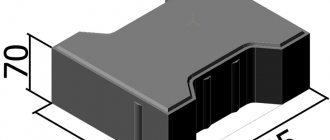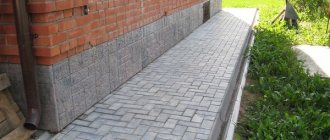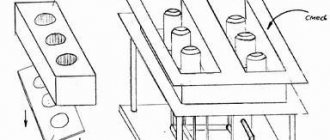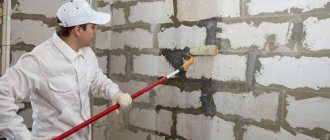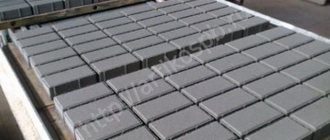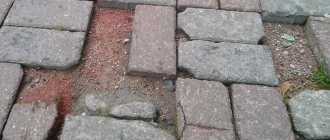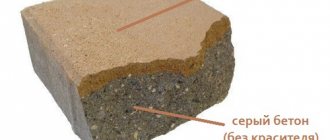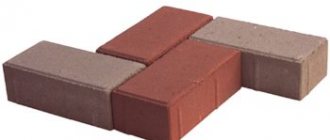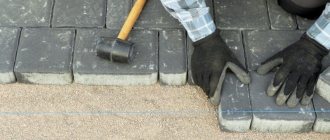The rise in prices for building materials has forced the market to look for options that would be attractive to the mass consumer. The use of foam concrete, expanded clay concrete and slag concrete has indeed become a real alternative to the use of traditional brick, especially in low-rise construction. In addition, such blocks, with their lighter weight and larger dimensions, allow construction work to be carried out much faster and save on masonry mortar. That is why the possibility of producing such blocks independently today is of interest to many entrepreneurs and private individuals who are undertaking large-scale construction. On an industrial scale, such building materials are produced using special equipment, while a block making machine can be used for other purposes. For example, for the production of facing materials, borders, elements of road infrastructure, and decorative products.
A brick making press is a complex specialized device for the production of piece building materials from concrete
Specifics of production of building blocks by vibrocompression
A brick press is a device that uses the principle of forming products using a vibrator by creating excess pressure (“load”).
Vibrocompression involves the use of a rigid concrete mixture, which contributes to the production of the most strong, durable and reliable products. Since this technology uses a “weight”, it becomes possible to use coarse aggregates, including materials that are waste from various industries. The use of expanded clay, slag, sawdust, broken bricks, and screenings reduces the cost of manufacturing building blocks. A brick making press involves the use of a rigid matrix, due to which the geometric dimensions of the blocks are more repeatable, which has a positive effect on the speed and quality of construction of load-bearing structures.
Sequence of operations when using vibration compacting equipment:
- the prepared working mixture is poured into a special measured form;
- a measured portion of the mixture enters the molding matrix, where it is compacted under the influence of the punch, while the proportion of air in the semi-dry mixture is reduced by more than half (up to 25%);
- during compaction of the mixture, a vibration mechanism is activated, and the combination of pressure and vibration forms the most dense cement paste, in which the filler particles are placed at a minimum distance from each other, while the air concentration in the mixture is reduced to 3-5%;
Since the working process is accompanied by high pressure on the mixture, various materials, including coarse-grained ones, can be used as fillers
- the impact of the punch lasts no more than a minute, after which the formed product is squeezed out of the matrix using an extruder (as an option, the matrix rises up, and the product remains on a special pallet;
- the resulting blocks are dried (naturally or by steaming).
The general scheme for making cinder blocks looks simple, but in reality a brick making press is a rather complex device in which all elements must be balanced, since they are forced to work under significant loads and vibrations.
Making cinder blocks on a machine
If the planned construction is not too large-scale, the blocks can be made without a brick press.
Making a mold
Cinder block mold
We assemble a mold measuring 40x20x20 cm. If you wish, you can adjust the dimensions at your discretion. To make the mold we use metal sheets or wooden boards.
The design is extremely simple: bottom and side walls. We fasten the walls taking into account the selected width and length of the block. The height of the edges of the form must also correspond to the planned height of the building elements.
Prepare empty glass bottles. You will use them to create voids in the blocks.
Mold option for cinder block
Filling the blocks
Pour the solution evenly into the mold to the brim.
Putting the mixture into the mold
Place the bottles with the neck up in the poured mixture. We level the surface of the fill, removing excess mortar.
Scheme of placement of bottles in filled blocks
We wait about 5 hours and take out the bottles. We leave the cinder blocks in the molds for a day, after which we carefully remove them and lay them out in stacks on a horizontal surface.
We leave the blocks to dry for a month. Only after the specified time can the material be used for construction.
Making cinder blocks
The machine allows you to significantly increase work productivity. The equipment has a fairly simple design.
Vibrating machine
Assembling the machine
The main element of a homemade vibratory compacting machine is a mold (matrix) for slag concrete mortar. By its design, this form is a metal box with internal elements in the form of voids. The void stoppers can also be removable.
We invite you to familiarize yourself with the existing standards for the construction of a private house
Compact cinder block machine
The work kit includes the following materials and tools:
- welding machine;
- standard set of locksmith tools;
- grinder;
- vice;
- sheet steel 3mm thick. It will take about 1 m2;
- a pipe with a diameter of 7.5-9 cm. Approximately 1 m of pipe is needed;
- metal strip 3 mm thick. You will need about 30 cm of material;
- electric motor with a power of 0.5-0.75 kW;
- nuts;
- bolts. Compact cinder block machine Side view Front view Front view
First step. We make a mold according to the size of the future blocks. We cut out the side faces of the matrix from sheet steel. We will make a form for 2 blocks at once. To do this, we cut out the inner central partition from steel and fix it in the box.
Second step. We determine the height of the elements to decorate the voids.
Third step. We cut 6 pieces of pipe along the length of the limiting cylinders to form voids.
Fourth step. We give the pipes a conical shape. To do this, we cut each piece of pipe longitudinally to the middle, compress it with a vice and connect it using a welding machine. We brew each cone on both edges.
Fifth step. We connect the stops in a row along the long edge of the cinder block. Along the edges of the row we add a 3-centimeter thick plate with holes for fastening with eyes.
Sixth step. We make a cut in the middle of each such compartment. We weld lugs on the back side of the form. They will allow temporary fastening of elements to create voids. A very convenient solution - it will be possible to remove the cylinders and make monolithic blocks.
Compact cinder block machine (press on top)
Seventh step. On the outside of one of the transverse walls we weld 4 bolts for the mounting holes of the vibration motor.
Eighth step. Using welding, we attach an apron on the loading side and blades along the edges.
Ninth step. We prepare all structural elements for painting - we clean them and thoroughly polish them.
Tenth step. We do the press. It will look like a plate with holes repeating the location of the holes in the block.
We make the plate of this size and fix it in such a way that it can go deep into the box at the place where the limiters are installed by 5-7 cm.
Finally, all that remains is to weld the handles to the press, coat the structure with a primer mixture and mount the vibration motor.
An ordinary electric motor can be converted into a suitable vibration motor. To do this, it is necessary to weld eccentrics onto the engine shafts. We won’t bother too much - we’ll just weld the bolts so that their axes coincide. To regulate the frequency and strength of vibration, screw nuts onto the welded bolts.
Vibration device
Cinder block machine
Making blocks
Recommendations for preparing the solution are given above. You can use the standard recipe or modify it at your discretion. The main thing is to obtain optimal viscosity. It can be determined “by eye” - the lump of mixture should hold its shape steadily.
Before loading the mixture, lubricate the contact metal surfaces with oil. Thanks to this, the solution will not stick to the iron.
We place the finished mixture into the matrix and begin pressing.
Place the filled forms on a vibrating plate and let it compact the solution for 5-15 seconds. After the specified time, add more solution to the mold, because previously loaded will inevitably settle.
We repeat the process, only this time we do not turn off the vibrating plate until the clamp reaches the limiters. We remove the mold until the machine stops.
Ready cinder block
We give the blocks 1-3 days for initial drying, carefully remove them from the blocks, lay them out on a flat horizontal surface and cover them with plastic wrap. The material can be used for its intended purpose no earlier than after a month.
Comparison of characteristics of cinder blocks and foam blocks
Good luck!
Design Features
The performance of the vibrating platform and the geometry of the finished products depend on the equipment. One of the main elements is the matrix, which is a steel box without a bottom. The matrix is installed on a pallet or on the surface of the extruder. Many models involve the use of the floor as a formative element. A punch is mounted above the matrix, driven by an electric motor, hydraulic drive, or manually using a lever block. The shape of the plane of the punch that exerts pressure on the solution must correspond to the geometry of the front part of the product.
The formation of vibrations involves the use of one or more vibrators (electric motors equipped with an eccentric) that transmit vibrations to all elements of the pressing mold.
Due to the fact that a rigid mold (matrix/punch) is used in the design of the blocking press, the geometry of the produced stones is clearer and repeatable
The brick making machine can be equipped with the following additional equipment:
- measuring bins for supplying concrete;
- conveyors for transporting/storing finished products;
- dispensers;
- mixers;
- steaming chambers for drying blocks;
- electronic control/monitoring systems.
Those who wish to carry out construction work using a vibrating compaction unit made in a handicraft manner should first familiarize themselves in more detail with the features and varieties of this type of equipment.
Preparation of the correct solution
The instructions assume the following recipe for preparing concrete for blocks:
- For seven parts of filler (coal slag from a blast furnace is best suited for this purpose), take two parts expanded clay (coarse sand), two parts gravel (5 - 10 mm), 1.5 parts cement (M500) and three parts water;
- The amount of water is approximate. It is important that the solution is not liquid. The correct consistency of the solution is checked by squeezing it in your fist. If it's the right consistency, it will stick together, but it should fall apart if you drop it on the ground;
- The quality of cinder blocks is increased by adding a plasticizer to the mixture (5 g per block). This will give the finished blocks water resistance, frost resistance and strength.
Classification of brick making machines
Vibration equipment for the production of blocks is manufactured by many large companies and small firms, many of which introduce a number of improvements to the design, which makes a clear classification of these devices difficult.
However, based on a number of criteria, it is possible to identify the main classes of brick making machines.
Mobile brick making machines are well suited for warm climate zones where they can be operated outdoors
By type of formation of block products:
The bed of a mobile concrete block press with the help of a wheeled chassis makes it possible to form cinder blocks directly on the surface of the construction site, which becomes part of its structure. In mobile vibrating machines, which are popularly called “laying hens,” the matrix, on which the punch presses, is pressed directly to the floor. After completing the manufacturing cycle, the matrix rises, leaving the manufactured product on the surface, moves to the required distance, and the process is repeated.
A typical mobile vibrating machine is characterized by relatively small dimensions and weight; it can be used directly at the construction site. There is no need to transport the blocks, but the requirement remains to dry the products under natural conditions, which takes some time.
Mobile brick making machines are subject to a number of requirements that narrow their scope of application:
- To deploy a vibrating machine, a construction site with an area of 300 square meters is required. meters;
- the working surface of the vibrating machine must be flat, since it is responsible for the formation of one of the sides of the product;
Self-production of a concrete block press
The use of the simplest and most accessible design (drawings of such brick making machines can easily be found on the Internet), at first glance, makes their manufacture a simple and low-cost task. And if we can agree with the last argument, then regarding complexity everything is not so simple. Any error in calculations will certainly affect the productivity of the manufactured vibrating machine, the quality of the mixture, and may cause its rapid failure.
If you are still determined to make a brick making machine with your own hands, you should carefully study those points that directly affect its performance characteristics. A vibration machine must be as durable as it can withstand vibration loads. When calculating the inertial parameters of its individual parts, one should take into account both the material of manufacture of the product and their geometry.
The first difficulties begin when selecting a vibrator unit. When using a rigid concrete mixture, a relatively large vibration amplitude of the vibrating installation is achieved. The vibrator is attached based on correctly carried out calculations according to a certain scheme - otherwise the compacted working mixture will “boil”, not ensuring uniform distribution of concrete throughout the form.
When using bolted connections, it should be taken into account that vibration loads on the product create the effect of unwinding them, similar to using a wrench, which requires mandatory fixation of such connections (use of cotter pins, lock nuts).
The simplest and cheapest to manufacture single-matrix brick making press includes the following structural elements:
- a sheet metal housing that serves as the matrix of the device;
- conical void formers (for hollow blocks) round or square;
- a punch with a lever mechanism that applies the required pressure to the concrete mixture;
- an electric motor with a calibrated eccentric of low power, which serves as a source of vibration for the installation.
A single-matrix vibrating machine is characterized by low productivity (it forms one building block in one cycle), which is not enough for the construction of large objects. For the construction of a country house or garage, such a home-made device would be an acceptable option, however, when building a country cottage, it is better to use a matrix with two or three or more shapes.
The potentiometer installed on the vibration machine makes it possible to regulate the amplitude of vibrations, which allows improving the operational characteristics of the unit even if errors were made during assembly.
The calibration of the brick making machine is carried out during its testing, which is carried out to check the sufficient stability and rigidity of the structure. An important condition for correct adjustment of the unit is the absolute horizontalness of the working surface.
The eccentric parameters are selected experimentally, making sure that the vibrations are not too amplitude. If desired, the design can be improved by providing a mobile platform, for which a lever system is used. Such a vibrating machine facilitates masonry work, allowing you to move the unit around the site.
The main criterion for independent production of a vibrating machine is preliminary calculations of the cost of the components, on the basis of which the cost of an individual building block is calculated (taking into account the costs of purchasing materials used to form a unit of product). And only if it turns out to be lower than when using purchased products, will making a vibrating machine with your own hands be justified.
Vibrating table manufacturing technology
Before making a vibrating table from rolled steel, you should consider the following nuances:
- the best option for connecting structural elements are rivets that can withstand vibration loads for a long time without destruction;
- in practice, in 99% of cases welding is used, so the vibrating platform is installed on the frame through damping springs;
- the height is selected individually, taking into account the build of the master, maintenance of the electric drive and the technology used for manufacturing FEM elements;
- the vibrator is always attached to the top plate with clamps or to a platform welded underneath.
The most economical and rational solution for a home craftsman would be the following option:
- prefabricated structure of a vibrating table necessary for the manufacture of garden borders, storm drainage trays and shaped paving elements in the quantity required for the site;
- after paving paths and parking lots with paving slabs, the vibrator is moved to a vibrating plate for final leveling and compaction of the cladding;
- The vibrating platform turns into a table top for a circular saw.
Universal collapsible vibrating table.
For these conditions, it is best to use site dimensions of 0.4 x 0.8 m or 0.6 x 0.8 m for greater stability. The clear height of the base is 0.8 m, with a spring-loaded platform of about 0.9 m, which is comfortable for user heights in a wide range of 150 – 185 cm.
bed
To work, you will need an angle grinder with metal equipment and a welding machine. To make a frame, you can choose any drawing of a vibrating table or take arbitrary dimensions. The structure is constructed according to the following method:
- welding two identical frames from a corner;
- assembling the frame by welding 4 racks to the frames.
Corner frame.
Instead of a corner, you can use any assortment, for example, legs made from a round pipe become ready-made guides for a spring of a suitable diameter, as in the bottom photo.
Pipe stands are convenient for placing springs.
For the specified conditions of a universal machine, the base will have the following design:
- supports – base 5 x 5 cm made of 1.5 mm sheet (nuts can be welded to adjust the height), legs made of pipe 4 x 4 cm with a wall of 1.5 mm;
- crossbars – bottom 2 x 2 cm, top 2 x 4 cm, wall thickness is the same 1.5 mm;
- for a removable platform, M14 x 40 bolts are welded at the corners;
- The electrics (socket + switch) are placed on a plate welded to the racks.
Placement of electrics on the frame.
With the indicated dimensions, jibs and stiffeners are not needed, taking into account small operating loads.
Vibration platform
The main condition for ensuring maintainability and mobility of the equipment is the removable cover-platform of the vibrating table for paving slabs and curbs. It can be made from various materials:
- steel sheet with a thickness of 2.5 mm - is expensive, but provides maximum structural life;
Steel table top.
- wood-containing chipboards, OSB or multi-layer plywood - a budget option for rare use; the frame of such a table top is made from a corner or a profile pipe.
Platform made of OSB sheet.
To secure the vibration motor from below in the center of the platform, you can use the following methods:
- strengthening the tabletop frame with a corner in the middle, welding a plate onto it, on which the electric drive will be mounted;
Fixing the engine with bolts.
- drilling through holes in the plate for fixing with countersunk screws or welding clamps to it from below (only for the metal version of the platform);
Fastening the vibrator to the plate with clamps.
- mounting the engine below, transmitting rotation by a belt to the upper shaft with an eccentric, mounted on bearings to the plate;
Vibrating table with eccentric shaft. This design allows the motor bearings to last longer.
To install engine vibration-intensifying springs, it is necessary to provide seating surfaces. Pieces of pipes are welded at the corners of the platform, into which the springs freely fit in 2–4 turns. If the frame is made from a corner, the springs can be welded to it or these damping elements can be placed inside exactly the same pieces of pipes. If the frame posts are tubular, then the springs are placed in these ready-made cups.
Springs in glasses.
Springs can not only be inserted inside glasses of larger diameter, but also put on pieces of smaller pipes. The length of such guides should be less than 1/3 of the size of the spring, both on the frame and on the table.
Springs on guides.
Less often, instead of springs, rope, cord or belt loops are used, from which the upper platform is suspended. However, these damping options are less reliable and increase the material consumption of the structure, since guides in the corners will have to be welded to the tabletop.
Belt suspension of the table top.
For our case of a combined table, we should use the following design:
- tubular frame – assortment 2 x 2 cm and 2 x 4 cm;
- table top – 3 mm sheet measuring 0.4 x 0.8 m or 0.6 x 0.8 m;
- guides - springs are put on M12 nuts and secured by welding;
- platform for the engine - 2 channels 4 x 8 cm (No. 8) across the frame.
Vibrator platform.
Important! The vibration motor is rotated along the long side, and holes for the motor are drilled in the channels.
The length of the channel should be slightly larger than the width of the vibrator legs to ensure maintainability of bolted connections and access to the unbalance of the electric motor (within 4 cm).
Vibration motor
It is impossible to make a vibrating table for the production of paving slabs without the main unit, which ensures vibrations of the upper platform. To do this, you can buy a ready-made vibrator or construct an eccentric unit from any existing electric motor of suitable power and size.
Factory vibrator
Taking into account the fact that the vibrating table will be upgraded into a circular table upon completion of the work, the optimal drive option is 220 V. It has amplitude adjustments, so the driving force can be set within a comfortable 1 mm. (Operating instructions for this engine)
Factory made vibration motor.
The main difficulty lies in adjusting the electric drive:
- the disturbing force is calculated by the formula F = 3 (M1 + 0.3M2)/100, where M1 and M2 are the mass of the machine and concrete, respectively;
- for the conditions under consideration, the disturbing force is approximately equal to 1.84 kN for forms with 6.5 kg of concrete and a countertop weight of 55 kg, and the vibrator produces a minimum of 5.6 kN, that is, 4 mm amplitude;
To reduce this force to an acceptable 0.5 - 1 mm, you must perform the following steps:
- the unbalance plates are moved apart to the maximum distance;
- a metal strip 2 x 6 cm is attached to one pancake (rigidly fixed on the shaft);
- the second oval hole is enlarged with a file until the amplitude decreases within 1 mm;
- The amplitude of the platform is measured with a pencil taped to it, the sharpened lead of which draws a curve at the moment the drive is turned on on a sheet of paper.
Measuring amplitude with a pencil.
Approximate settings for the specified weight of the platform and forms with concrete mixture should begin with a distance between the holes of the unbalance plates of 38.5 mm.
Unbalance adjustment.
Homemade vibration drive
A primitive example of a vibration drive is a piece of reinforcement (bolt, drill) bent in a vice and clamped into an electric drill. When turning on a tool secured with a clamp and adjusting the speed, the curved edge introduces imbalance, creating vibrations.
This option is not suitable for long-term operation, since the drill bearings break, friction parts wear out, and the motor winding burns. When using a used electric motor, a circuit similar to factory vibrators is usually used:
- one or two eccentric blocks are placed on the shaft key;
- the amplitude is adjusted according to the above method.
Homemade eccentric.
Advice! Your vibrating table, made according to the given instructions, must be grounded, and an RCD must be mounted in front of the extension cord to power the equipment.
Making a tile vibrator with your own hands
The structure consists of a metal or plywood plate (multilayer plywood with a thickness of at least 10 mm is used), a vibrator with an eccentric and a drive motor. An electric motor is usually used.
Such a mechanical vibrating plate can be used not only for surface preparation and direct compaction of laid paving slabs. With its help you can prepare any flat area.
But the most significant savings are the production (and not the purchase) of paving slabs or paving stones. In this case, it is not necessary to purchase industrial equipment; you can make a brick press with your own hands.
Device for movable connection between table and tabletop
To ensure vibration of the tabletop, its connection to the table should not be rigid, but the amplitude of vibrations should be limited. One of the possible design solutions in this case is to install the tabletop on springs attached to the table.
This stage of work begins with the selection of six steel springs of acceptable rigidity, 10-12 cm long and 5-6 cm in diameter. Then, from a pipe of suitable diameter (a spring should be inserted inside freely, but without a significant gap), cut 12 pieces with your own hands - “glasses” long 1/3 of the length of the springs.
Six glasses are welded at the four corners and two middles of the large sides of the table on top, and the remaining six are welded to the corresponding places on the tabletop below. For preliminary precise marking, the tabletop is placed on the table in the working position, six glasses are inserted between them at the design locations, around which the installation locations are outlined in chalk.
The principle of operation of a vibrating table for tiles
The easiest way is to cast tiles into ready-made molds. However, the resulting material is loose and inferior in strength even to ordinary concrete. In addition, due to its compact size, it is difficult to achieve uniform shrinkage of the mixture.
As a result, strong bonds are not formed between the constituent components, and air voids remain in the body of the tile. In addition to the banal loss of strength, water penetrates into cracks and cavities. At sub-zero temperatures, the resulting ice will break the stacked blocks.
To obtain denser and higher-quality artificial stone, equipment for the production of paving slabs is equipped with a vibrator. Industrial designs work precisely on this principle.
A tile vibration press produces durable stone with a smooth front surface that does not allow moisture to pass through.
The mixture is loaded into the mold, then it is compacted by pressure and vibration, after which the stone dries under certain conditions. The more powerful the pressure is applied to the material, the better the quality of the final product.
Moreover, the best density is obtained when using vibration compaction, that is, simultaneous exposure to pressure and vibration.
Such a machine costs a lot of money; for the production of blocks at home it is an unaffordable luxury (unless, of course, you are engaged in commerce). Therefore, for one-time work, it makes sense to make a brick press with your own hands.
Making a mold for cinder block
Mold for blocks with bottle voids
In this form, a concrete solution with a high water content is used. It is also called “soft”.
- Filling the molding box or matrix with concrete;
- Keeping the solution in the mold until it sets (several hours);
- Disassembling the mold - the block arrives in a free state.
The walls and bottoms of these molds can be made from metal plates or sheets of plywood. Before pouring the solution into the mold, it should be lubricated with used machine oil.
Complex machine (vibrator and press)
The vibration pressing device consists of two independent parts. The table with the matrices installed is attached to the frame using spring dampers. A rubber suspension can be used if sufficient vibration amplitude is provided. To dampen transverse vibrations, it is advisable to install a guide.
It is better to make the working surface massive so that there is no resonant buildup. A vibrator is rigidly attached to it. The principle of operation is the same as in the tamping installation (see part 1 of the article).
This design works well on a massive tile making machine. A hydraulic installation or a regular jack is used as a press. Depending on the components you can find, you can make a press driven by an electric motor.
The movable carriage moves along vertical guides using a chain mechanism. The structure is driven by a reduction gearbox, which can be organized using different gear ratios of the chain sprockets.
The press pusher has damper spring inserts that regulate pressure and protect the chain transmission from excessive loads. Limit switches are installed on the vertical guides. When the pusher lowers to the working position, the engine turns off.
The workpiece is compacted using vibration of the work table. The pressure is regulated by moving the limit switches, which allows you to experimentally select the force for various mixtures.
After lifting the pusher, the workpieces hold their shape well. They can be carefully removed from the matrix without waiting for the mixture to harden. This technology makes it possible to organize a continuous process for the production of paving slabs using vibrocompression.
An example of how a homemade brick making machine works - video
To make such a brick press with your own hands, you do not need expensive materials (despite the bulky design) . Metal profiles and angles can be purchased inexpensively at scrap metal collection points.
The motors are suitable from any old industrial electrical installation: decommissioned machines or ventilation systems. Springs can be taken from car dismantling sites, or from decommissioned agricultural machinery.
After selecting the components, a drawing is drawn up (it cannot be standard, since the work plan depends on your needs for the tiles and the availability of parts). Assembly is carried out by welding.
Bolted connections can become weak from constant vibration, and you will be forced to regularly tighten all fasteners. If the installation turns out to be large enough (depending on the power of the motors found), you will also receive a brick press for the production of the so-called French stone.
It is enough to just slightly modify the matrix and reduce the pusher pressure.
Homemade vibrating table and its application
A vibrating table is a movable table with a vibrator attached to it - the already familiar electric motor with an eccentric. Its purpose is the production of paving slabs, figures, statues, etc. by vibration casting method, as well as from composite blocks.
To make building blocks, molds filled with mortar are placed on the table surface. The process of forming blocks is approximately the same as on a vibrating machine. Champagne bottles are sometimes used to form voids.
When producing paving slabs and other building and architectural elements using the vibration casting method, appropriate forms are installed on the table. for the production of colored paving slabs is as follows:
- sand – 1 part;
- cement M500 – 1 part;
- crushed stone with a granule size of 10-20 mm – 2 parts;
- dye – 5%;
- plasticizer – 2%.
The technology of its production was described above.
We hope that the descriptions given will help not only to make a homemade vibrating machine or vibrating table, but also to organize the production of the necessary concrete products with their help.
Didn't find the answer in the article? More information
The presence of a brick making machine on site significantly speeds up and reduces the cost of construction work. With this device you can make your own cinder block. However, to obtain high-quality building material, it is necessary to follow the technology of working with a brick making press. We’ll look further at how to choose, build and properly use a brick press for cinder blocks.
Characteristics and principle of operation of a brick making press for the production of cinder blocks
The operation of a brick making press is based on the use of impact force, with the help of which it is possible to obtain vibration. To create pressure, a hydraulic or gravitational load is used. It is thanks to this technology that it is possible to give the concrete solution a certain shape and strength.
In order for the product to acquire a special shape, a matrix is used, which varies in size, configuration, height, depth, etc. By purchasing or making a brick making machine yourself, you can obtain highly efficient equipment, the productivity of which is at a high level, and the finished building materials pay for themselves within a month.
Using a brick press, it is possible to produce not only cinder blocks, but also materials in the form of paving slabs, wall stones, paving stones, elements for creating partitions, etc.
There are several domestic companies engaged in the manufacture of brick making machines. The most popular of them is the Ural plant “Stroytekhnika”. This equipment is characterized by a high level of performance, affordable cost and good performance characteristics.
Considering the principle of operation of a brick making press for cinder blocks, we will divide the entire production process into two stages:
- composition preparation;
- its formation.
Initially, all components of the composition are mixed together. It is this stage that is decisive in determining the future physical properties of the material. At this stage, the quality of the finished product and its cost are determined.
It is possible to mechanize or automate this process. That is, not every equipment is capable of forming a composition. In some cases, this work is done manually or using a concrete mixer. But in most devices, a mixer is used to mix the components together, the armor of which prevents additional friction.
The next stage is the formation of the cinder block. For this, a vibration unit or a special table is used. To give the solution a certain shape, it is placed in a matrix. The lower part of the product is on a pallet, which ensures its flatness from below. The composition located inside the matrix is affected by vibration and a certain load.
Thus, it is possible to achieve maximum distribution of the composition over the walls of the matrix; the products are characterized by uniformity, good strength and a previously defined geometric shape. Therefore, when purchasing a brick making machine, it pays for itself in a short time, and it is possible to obtain building material much cheaper than its market value.
How to build a cinder block vibration press with your own hands
Cinder block is accessible and widely popular. Various types of non-residential premises are erected from this building material. By building a brick press for a cinder block with your own hands, you will be able to save a lot. However, you should take into account the fact that when working you will need skills in working with a welding machine and metalworking tools.
Also, keep in mind that the final version of the cinder block will be inferior in quality to the purchased version. In home production, steaming technology is not maintained, during which the material is saturated with a certain amount of moisture, which improves its strength. However, with the help of such blocks it is possible to construct buildings with a service life of about thirty years.
The main part of the cinder block brick making press is the matrix. It has the shape of a steel box, inside of which previously provided parts are installed, with the help of which voids are formed. In order to build a matrix with your own hands you will need:
- welding;
- grinders with special attachments;
- vice;
- additional tool.
Also prepare materials in the form of:
- metal sheet material, 3-4 mm thick;
- pipes, diameter 9 cm;
- electric motor;
- special strips4
- clamps and additional fasteners.
Before starting work, prepare drawings of a concrete block press for cinder blocks and study them in detail. All parts are made in relation to them.
Decide on the dimensions of the future product. In relation to them, cut blanks from a metal sheet for the frame part of the matrix. There should be a partition inside. The box should contain two equal compartments. Next, decide on the height of the parallelepiped, which will serve as a void limiter. Cut the pipe into eight parts, each of which is equal in height to the cylinder. In order for the cylinder to acquire a cone-shaped shape, cut each of them to the center, grab it in a vice and weld it in this position using a welding machine.
In this way, it will be possible to reduce the diameter by several centimeters. On each side the cylinders are welded together. Connect the cylinders in such a way that voids are formed as on the factory blocks. Weld lugs on the reverse side along the central part of each hole in the matrix. Thus, it will be possible to produce not only cinder blocks with voids, but also monolithic materials. The matrix will acquire universal use.
Weld four bolts onto the outer wall; the vibration motor will be attached to them. The blades and apron are welded along the extreme sections of the matrix. Next, all parts are cleaned and polished. Install comfortable handles on the mold, with the help of which it can be easily removed from the matrix. Paint all parts and coat them with anti-corrosion compounds. Take care to install the vibration motor. .
In order to convert a conventional electric motor into a vibration installation, you need to add several shafts and eccentrics to it, for which use ordinary bolts. Try to ensure that they coincide along the axis. To select the desired vibration frequency, screw the nuts onto the bolts and gradually adjust this indicator.
Using this matrix, it is possible to build a walking or stationary machine for the production of cinder blocks.
Next, we will focus on how to independently build a vibration table to which the matrix will be connected. The operating principle of the vibrating table is based on the transmission of vibration from the motor to the table roof. To further dampen vibration, shock-absorbing pads or springs are used.
A matrix is installed on the table top, inside of which there is a solution that is susceptible to vibration. Thus, cinder block production is carried out. During the process, you will need mechanics' hand tool skills. In addition, you should prepare materials in the form of:
- steel corner, about 600 cm long;
- rectangular pipe;
- steel sheet;
- large springs;
- asynchronous motor;
- bolts, nuts and other available materials.
All materials are thoroughly cleaned from corrosion and processed with grinding equipment. The main part of the table is its frame. To make it you will need a steel corner. The main function of the frame is to hold vibration damping points in a stationary position. In order to build a frame, cut a corner of a certain size and connect it together using a welding machine. Next, weld the legs to the frame and weld the springs on the top.
The cover will not be held firmly to the base of the frame; it will rest against the springs. Special sides will prevent it from falling during the cinder block production process.
To make your own lid, follow these steps:
- cut the profile pipe according to the dimensions of the workpieces in the drawing;
- weld them together, you should get a frame similar to the table frame;
- install a platform on the stiffeners on which the motor will be fixed;
- Weld rings into the corners of the lid, and also weld a metal sheet onto the surface.
Next, start building a vibration motor, which is responsible for activating vibration. In order to obtain the required level of vibration, unbalance the motor shaft by adding eccentrics in the form of bolts to it. Use nuts to tighten the bolts. Try to place the load evenly on each side. In this way, it will be possible to achieve maximum vibration effect.
The weight of the load determines the engine power, which is determined by the general parameters of the vibration installation.
Further actions are aimed at connecting all the parts into a single structure. The engine is installed on the seat using bolts. Each feed drive is equipped with an automatic machine. The lid and the motor fixed on it are installed directly on the table.
Please note: The table, after mounting it on the work surface, must be grounded. Take care of your safety and do not neglect this advice.
Depending on individual needs, additional modifications to the design are possible. In addition, it is recommended to paint the vibrating table to increase its service life. Securely install the frame on the supports, and only then start the unit. Using this table you can make cinder blocks for home use.
If you decide to buy a vibrating press for cinder blocks, then it will cost you several times more than a homemade mechanism. In any case, by taking out an installment plan for a brick making machine for cinder blocks, you can quickly pay for this device. The price for a brick making press for cinder blocks is determined by the following parameters:
- device power;
- installation performance;
- type of brick making machine: stationary or mobile;
- universality of use or single production of materials;
- availability of additional functions.
In general, a mobile concrete block press is quite suitable for home use; it can be easily moved around the site, has a lower cost than a stationary one, but has lower productivity.
Stationary installations are suitable for the industrial production of cinder blocks; as they operate, they pay for themselves within a few months. To connect them to the network, a three-phase meter is most often required, so be sure to take this parameter into account when choosing an installation for making cinder blocks.
Simplified design of a brick making machine
For small volumes, you can do without a powerful mechanically driven press. The matrix can also work on “manual” traction. The work table on the bed is made in exactly the same way (on dampers), and the vibration unit is placed on the moving part of the machine (pusher).
If you are making a brick press with your own hands to lay one or two tile paths, this scheme is perfect. With this design, a stop for the vibration drive is installed on the pusher, and the unit itself is made more massive.
It is more convenient to make the pusher on a rotating rod, then the matrix can be quickly filled with the prepared mixture.
A vibration-driven lever equipped with handles is installed on top. The operator sets the stop on the matrix and lowers the lever onto the stop. The shrinkage of the mixture occurs due to the weight of the pusher and vibration drive. The seal is adjusted manually and an adjustable stop is provided to maintain the height of the tiles.
The productivity of such a machine is lower than that of a design with a mechanical press. The main advantage is compactness and ease of manufacture.

